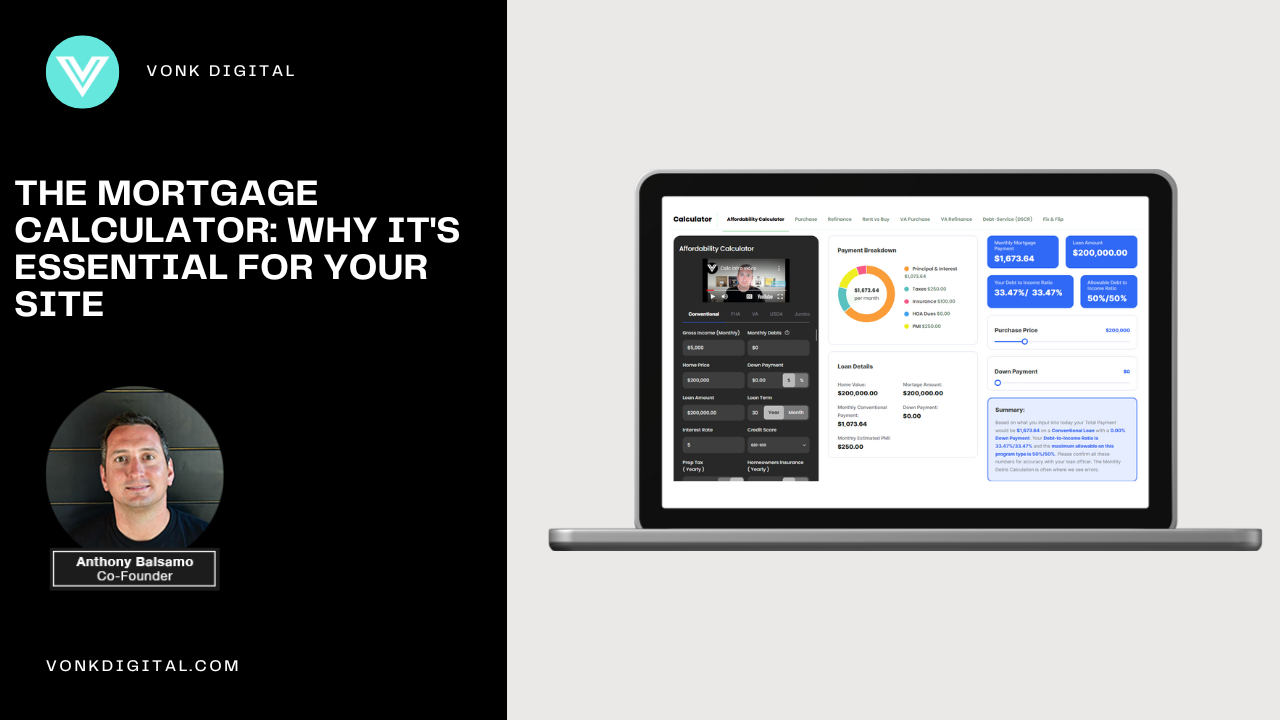People want to be able to do their own research on everything these days. The…

In the competitive mortgage business, it’s important to have a good website to get and keep customers. Keeping up with your mortgage website shows that you know what you’re doing and what you can offer. It also gives people who want to borrow money more confidence and makes the whole process easier.
Mortgage Website Maintenance
Mortgage website maintenance means managing and improving a website for mortgage companies. To make sure users get the latest and correct info, we need to update, monitor, and improve the website. To maintain a mortgage website, tasks include updating content, fixing broken links, speeding up the site, improving user experience, and following industry rules. Businesses can improve their online presence, draw more visitors, and boost conversion rates by actively managing a mortgage website. To stay competitive in the digital age, it’s important to offer efficient service to customers.
Why You Should Maintain Your Mortgage Website
Regularly maintaining your mortgage website is essential to ensure long-term online success. By regularly maintaining your website, you can reap numerous benefits that will enhance its overall performance and security.
One of the key benefits of regular maintenance is improved website performance. To make sure your website runs smoothly, update it regularly with the latest software and security patches. Regular updates also help optimize website speed and accessibility, providing visitors with a seamless browsing experience.
Website maintenance is also essential for enhancing security. Regular security updates protect your website from malware and cyberattacks, safeguarding sensitive information such as mortgage applications and borrower data. By prioritizing security measures, you can instill trust in your visitors and mitigate potential risks.
Furthermore, regular maintenance contributes to boosting search engine rankings. Search engines favor websites that are regularly updated and well-maintained. By consistently optimizing your website with fresh content, relevant keywords, and user-friendly features, you can improve your ranking and visibility, driving more organic traffic to your site.
Additionally, regular maintenance plays a crucial role in lead generation. If you update and improve your website regularly, it will be easier for people to use and more likely to turn visitors into leads. A well-maintained website with clear call-to-action buttons and user-friendly forms encourages visitors to take the desired actions, such as filling out a mortgage application or contacting your company.
Regularly maintaining your mortgage website has many advantages. It improves performance, boosts security, increases search engine rankings, and generates more leads. By regularly maintaining your website, you can keep it updated, secure, and effective for your business.
Overview of Maintenance Tasks
To keep a mortgage website successful, you need to give it constant attention and care. To keep your website running smoothly, there are important tasks involved in website maintenance. These tasks include regular software updates and security patches to optimize performance and protect against cyber threats. To improve search engine rankings and attract more visitors, you need to update and optimize your content regularly. In addition, website maintenance includes making it easy for users to take action and generate leads. To improve your mortgage website’s performance, security, and visibility, focus on these maintenance tasks. This will help you succeed in the competitive online market.
Security Updates and Patches
It is important to keep your mortgage website secure so your visitors have a safe online experience and their sensitive data is protected. One essential aspect of website security maintenance is regularly installing security updates and patches.
Security updates and patches are software releases that address vulnerabilities and fix bugs in your website’s underlying technology. These updates may include fixes for potential security breaches or weaknesses that could be exploited by cyberthreats. By promptly installing these updates, you can protect your website from being compromised and safeguard confidential information.
To implement security updates and patches, you should regularly check for updates from your website’s content management system (CMS) or hosting provider. Most CMS platforms offer automatic update options that can simplify this process. By enabling automatic updates, your website’s security will be automatically strengthened as new patches are released.
Additionally, it is essential to regularly backup your website before applying updates. Backups provide a safety net in case any issues arise during the update process. If an update causes compatibility or functionality issues, you can quickly restore your website to its previous state.
To protect your mortgage website from cyber threats, prioritize security updates and patches. Maintaining a secure website not only helps build trust with your visitors but also ensures compliance with industry regulations and standards.
Back-ups and Data Protection
Regular backups and data protection are crucial for maintaining a professional mortgage website. Backing up website files and databases is essential to protect against potential data loss.
In the mortgage industry, sensitive and confidential information is often stored. That’s why robust data protection is extremely important. Regular backups ensure that if any unforeseen issues arise, such as a website crash or a security breach, you can quickly restore your website to its previous state.
To ensure the integrity of your data, it is recommended to use secure backup solutions that offer encryption and off-site storage. By encrypting your backups, you add an extra layer of protection against unauthorized access.
The frequency at which backups should be performed depends on the amount of content and updates your website experiences. As a general rule, it is advisable to backup your website at least once a week. However, if your website experiences frequent changes or updates, more frequent backups may be necessary.
Regular backups and data protection are crucial for maintaining the security and integrity of your mortgage website. By implementing a robust backup strategy, you can minimize the risk of data loss and ensure the continuity of your online presence.
Software Version Updates
Software version updates are an essential part of maintaining a professional mortgage website. Staying up-to-date with the latest software versions is crucial for ensuring website security, compatibility, and performance.
First and foremost, software version updates help bolster website security. As cyber threats continue to evolve, keeping your website’s software up-to-date is a proactive measure to prevent vulnerabilities. Updates often include security patches that address any known weaknesses, reducing the risk of potential breaches or data leaks.
Software updates not only provide security, but also make sure they work well with other plugins, themes, and technologies. As web development advances, older software versions may not work well with new components. By regularly updating your software, you guarantee that your mortgage website functions seamlessly with other tools and technologies.
Moreover, software updates are crucial for maintaining optimal website performance. With each update, developers often introduce enhancements and optimizations that improve the overall speed and efficiency of your website. These improvements not only enhance user experience but also contribute to your website’s search engine rankings.
Implementing software version updates involves a few key steps. Begin by regularly checking for updates from the software provider. Once updates are available, thoroughly test them for compatibility with your website’s existing components. To ensure a smooth update process, it is essential to also update any plugins and themes that rely on the software. Finally, continuously monitor your website after updating to identify and address any potential issues promptly.
By prioritizing software version updates in your mortgage website maintenance routine, you can ensure robust website security, seamless compatibility, and optimal performance.
Performance Monitoring/Optimization
Performance monitoring and optimization are essential for maintaining a professional mortgage website. Regularly assessing website speed, load times, and overall functionality ensures a positive user experience.
If a website loads slowly, visitors get frustrated and leave quickly, making users unhappy and decreasing sales. To improve your website’s speed and functionality, monitor performance metrics and find areas to optimize. This will engage visitors and encourage further exploration.
Moreover, optimizing website performance has a direct impact on search engine rankings. Search engines like Google consider website speed as a ranking factor, meaning faster-loading websites are more likely to appear higher in search results. This increased visibility can attract more organic traffic and potentially generate more leads.
Additionally, a well-optimized website enhances the user experience, improving customer satisfaction and trust in your brand. A smooth browsing experience, quick load times, and easy navigation help users. This can increase conversions and repeat business.
Check website metrics regularly, find areas to improve, and optimize for optimal performance. This proactive approach ensures that your mortgage website remains competitive, delivers a positive user experience, and achieves higher search engine rankings.
Accessibility Testing
Accessibility testing is a crucial aspect of maintaining a professional mortgage website. It ensures that individuals with disabilities can access and navigate the website effectively, providing an inclusive user experience for all visitors.
To test if a website is accessible, you need to follow the WCAG standards. These guidelines outline best practices for making web content accessible to people with disabilities. By adhering to these standards, mortgage websites can ensure that their content is perceivable, operable, understandable, and robust.
To conduct accessibility testing, website owners can utilize various tools and assistive technologies. These tools find and fix accessibility problems, like missing alt text or improper headings. Devices like screen readers, magnifiers, and voice recognition software mimic the experiences of people with disabilities. They also help find areas to improve.
During testing, it is important to check the website’s compatibility with different browsers, platforms, and devices. This ensures that individuals using different devices or assistive technologies can access the website without any difficulties.
Mortgage websites can make sure people with disabilities can fully engage by doing accessibility testing. They can fix any issues found, so individuals can navigate and use all the features. This not only ensures inclusivity but also helps meet legal requirements and demonstrates a commitment to accessibility.
User Interface and Design Updates
Regularly updating the user interface and design of your mortgage website is crucial for maintaining a positive user experience and attracting and engaging visitors. A website with outdated design elements and a cluttered interface can be a deterrent for potential borrowers and may lead to high bounce rates.
By implementing user interface updates and design improvements, you can enhance the overall user experience on your website. This includes making the layout clean and intuitive, improving navigation menus, and optimizing the website for mobile devices. With an increasing number of users accessing websites through their smartphones and tablets, having a mobile-friendly design is essential for reaching a wider audience.
Moreover, keeping the design of your mortgage website modern and visually appealing is important for building trust and credibility. A visually appealing website can create a positive first impression and leave a lasting impact on your visitors. This can play a significant role in boosting conversion rates and generating leads.
To ensure that your mortgage website remains user-friendly and intuitive, it is essential to regularly review and analyze user behavior and feedback. This will help you identify areas for improvement and make the necessary adjustments to optimize the user experience.
In conclusion, regular user interface and design updates are necessary to maintain a professional and effective mortgage website. By focusing on mobile optimization, visual appeal, and user experience, you can attract more visitors, keep them engaged, and ultimately drive business growth.
Steps for Implementing a Maintenance Plan
Maintaining a professional mortgage website requires a well-structured maintenance plan. By regularly updating and monitoring your website, you can ensure its optimal performance and user experience. Implementing a maintenance plan involves several key steps.
- Content Management: Regularly review and update your website’s content to ensure its accuracy and relevance. Keep your mortgage information and product details up-to-date, and add new content to engage visitors and improve search engine optimization.
- Security Monitoring: Protect your website and sensitive customer information by regularly monitoring for potential security threats. Install security plugins, regularly update software, and perform backups to safeguard against hacking attempts and data breaches.
- Performance Optimization: Continuously optimize your website’s performance to provide visitors with a seamless browsing experience. Regularly run speed tests, optimize images, minify code, and leverage caching techniques to improve page loading times.
- Support and Bug Fixes: Establish a process for troubleshooting and resolving any technical issues or bugs that may arise. Promptly address user feedback and complaints to ensure a smooth user experience and maintain customer satisfaction.
- Regular Backups: Regularly back up your website’s files and databases to protect against data loss or corruption. By creating routine backups, you can quickly restore your website in case of any unforeseen issues.
- User Experience Analysis: Continuously analyze user behavior and feedback to identify areas for improvement. Gather insights through analytics tools, user feedback forms, or surveys to make data-informed decisions and enhance the overall user experience.
By following these steps, you can maintain a professional and user-friendly mortgage website that attracts visitors, generates leads, and builds credibility in the industry.
Assigning Responsibilities/Developing an Action Plan
Assigning Responsibilities and Developing an Action Plan
One of the key aspects of maintaining a professional mortgage website is assigning responsibilities and developing an action plan. This ensures that all tasks are systematically managed and completed on time, contributing to the overall success of your website maintenance plan.
To assign responsibilities effectively, start by identifying the different tasks that need to be performed regularly. These tasks may include content management, security monitoring, performance optimization, support and bug fixes, regular backups, and user experience analysis.
Once you have identified the tasks, assign them to the appropriate team members based on their expertise and availability. Clearly communicate the responsibilities to each team member and provide any necessary training or resources to ensure they can successfully carry out their assigned tasks.
Next, develop an action plan to track the progress and deadlines for each task. Set specific timelines and deadlines, and regularly review the plan to ensure it remains on track. Consider using project management tools or spreadsheets to keep everyone accountable and facilitate communication and collaboration.
Regularly evaluate the progress of the action plan and make adjustments as needed. Encourage open communication among team members to address any challenges or roadblocks that may arise.
By assigning responsibilities and developing an action plan, you can ensure that all aspects of your mortgage website maintenance are effectively managed and maintained, leading to a professional and successful online presence.
Frequently Asked Mortgage Website Questions
How much does it cost to pay someone to maintain a website?
The cost of website maintenance can range widely based on the site’s complexity and specific needs. Typically, monthly fees can range from $30 to $5000. Higher-end maintenance can include security monitoring, updates, hosting, and support services.
What is the normal cost for a website?
The cost of creating a website can vary greatly, from $100 to $30,000 or more, depending on complexity, design, and functionality requirements. Domains and hosting are recurring costs, while design and development are typically one-time expenses.
What is usually included in website maintenance?
Website maintenance usually includes updates to software and plugins, security monitoring, backup and restoration services, hosting, and domain renewal. It can also cover content updates, SEO optimization, and performance monitoring to ensure the site remains effective and operational.
Conclusion
In the mortgage industry, it’s crucial to have a clean online presence. This helps you be a trusted middleman between your company and borrowers. To create a good mortgage website, you need to do several things: update it often, make sure it’s secure, and focus on the needs of the users. To achieve long-term success and satisfy borrowers, adopt a maintenance plan. This plan will help you have a good online presence. It will also make it easier for you to attract and support borrowers when they are buying a home.



